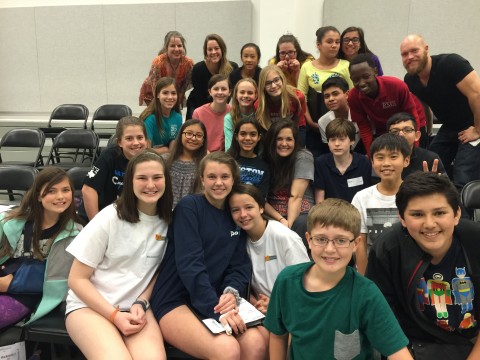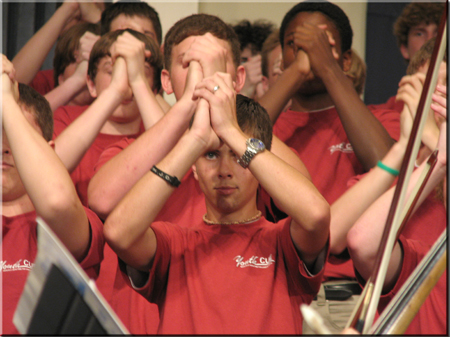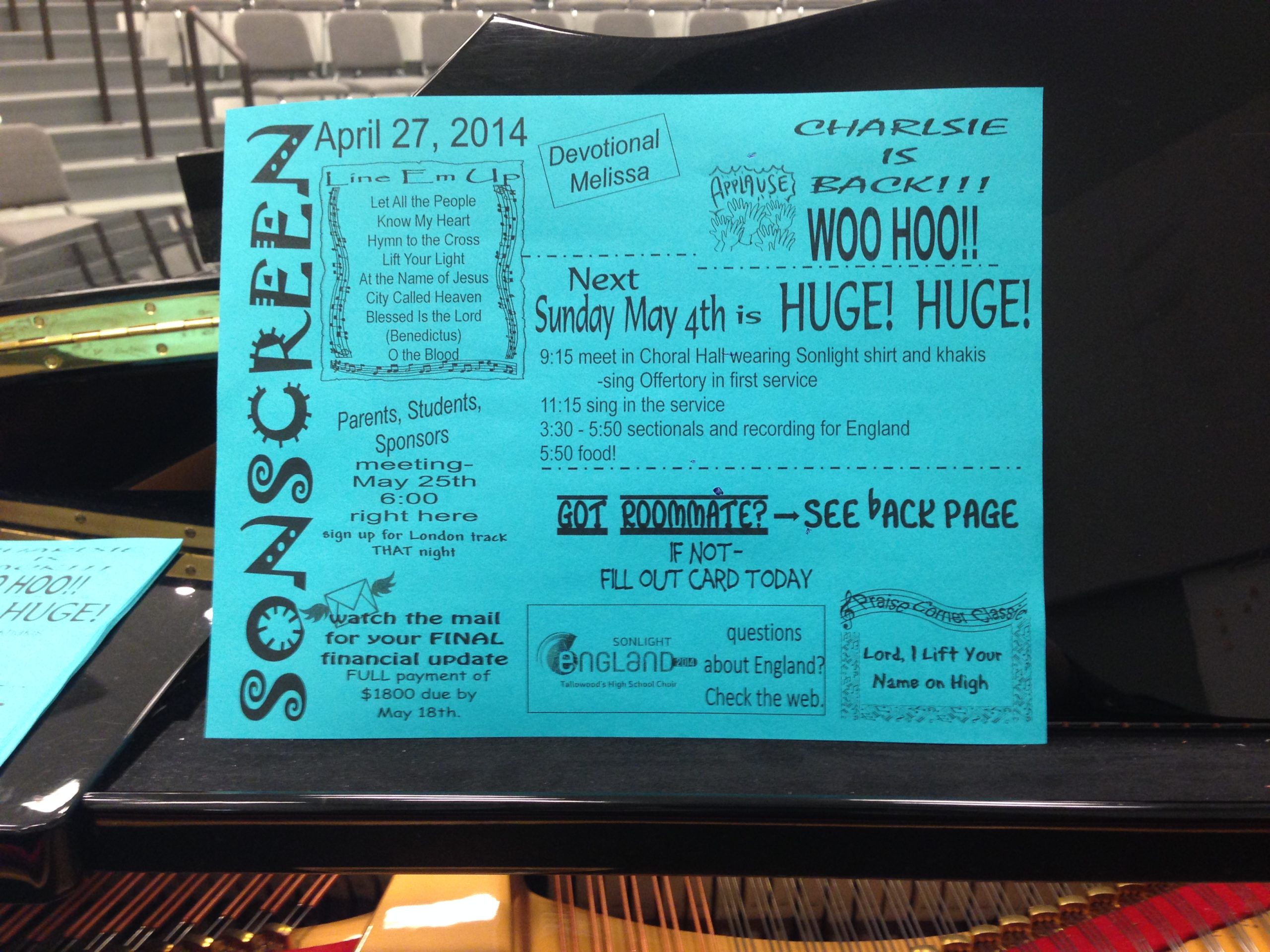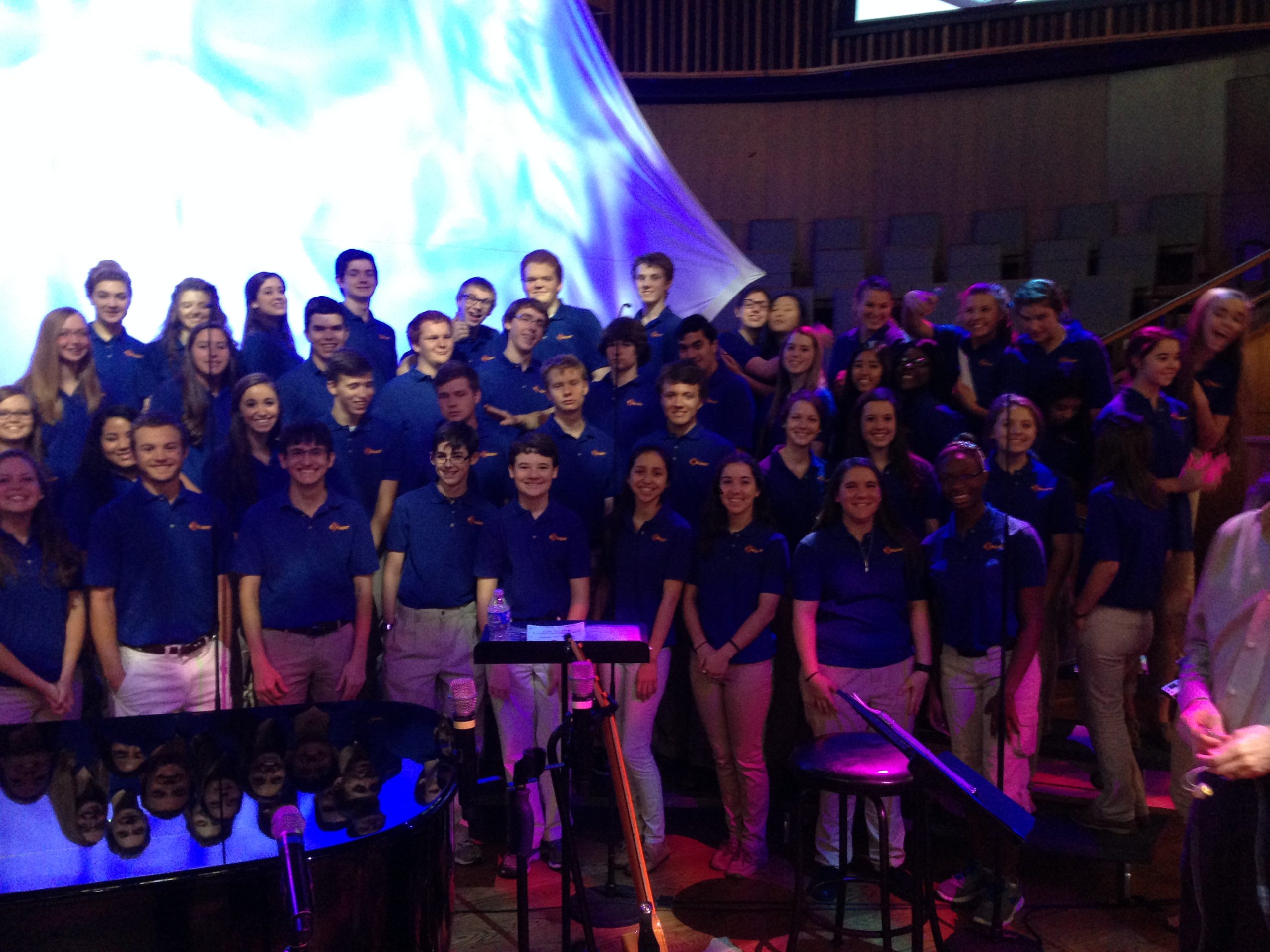A few months ago I began a continuing series on the next generation of youth choir directors.
This week I continue with an interview with Leslyn Jacks, Tallowood’s junior high choir director.
In addition to the interview, I also attended one of the rehearsals of Heartlight, so this posting will be in two pieces—interview and then observation.
In the picture above Leslyn is the one in the middle of the crowd of kids.
Interview
RK: You are a choral director, what experiences growing up helped to solidify that calling you have for a career?
LJ: My Dad is a choral director, so I grew up being a part of the children’s choirs and youth choirs at our church. I knew I enjoyed being a part of the ensemble, so I figured I would probably enjoy directing groups as well (and I was right!) (NOTE: her father is Carlos Ichter, Minister of Music and Worship here at Tallowood Baptist Church in Houston)
RK: What did “Youth Choir” at church add to your growth as a choral director?
LJ: So very much! I loved going on mission trips with my youth choir and using music to minister to people all over the world. Those trips showed me how music can change the lives of people who are listening.
RK: In addition to being a choral director, you also lead contemporary worship. Do you see a connection between the two?
LJ: There is certainly a connection. I consider my choir members to be worship leaders. I make sure that they understand the importance of what they are doing when they are singing in front of a congregation regardless of the style the worship service might be in—traditional or contemporary.
RK: When you look into the crystal ball, how do you see youth choir ministry in the future?
LJ: In the future I think youth choirs will find their role in all kinds of worship settings. That it why they need to have a wide variety in the music that they sing so that it can speak into any worship “language” that is being spoken—traditional, contemporary, or whatever is “next.” Doing that improves their musicianship, especially if they are not involved with choir at school.
Observations from Heartlight rehearsal under Leslyn’s baton (although she didn’t use one)
Before the rehearsal begins, Leslyn is there early and ready to go.
As the students come in she talks to them about her kids at school, what they are singing, she asks the Heartlight students questions about their lives.
She connects to them, relates to them, and immediately puts everyone at ease.
Gradually she begins warm-ups a physical one, getting them up and moving a bit.
Then, gradually starts having them sing—on an AH first. She uses the “I know, I know, I know, I know” (1-8, 8-5, 5-3, 3-1) and says cute phrases between them, “I love Chic-fil-a” “I am going to have a baby” etc.
She sings a fun non-sensical song with them, keeps them singing and laughing too.
She reminds them of the line up on the “Awesome” (Heartlight’s choir handout) and has them make sure music is ready and in order.
She sings “We Believe” with them.
She uses positive reinforcement—”that sounds so much better than last week, but here is what I would like for you to try. Sit on the edge of your chair and see if you can give me more energy in the sound”
The junior high choir eats up the challenge and immediately look and sound better.
They get to a 3 part harmony part, but they are still singing melody, instantly the pianist switches to playing parts without being prompted. I am reminded that a good director empowers his/her accompanist to make decisions to help the young singers when they are in need.
She transitions quickly back through to give them a chance to seamlessly go into the harmony section and now that they have heard it, they do it well.
She immediately praises them and moves on to the next song: “We Are Not Alone”
She reminds them that the solo auditions for this song are tonight right after rehearsal. So she sings the solo for them, and then asks everyone to sing it. “You may decide you want to audition when you see how easy it is to sing it.”
Since dynamics are essential in this piece, she had them experience singing very softly but with energy, then gradually crescendo and diminuendo.
Then to the next song: “Be Not Afraid”
After briefly checking some parts for accuracy, she noted the vowel sound that they made on “not” and “you”.
Let me demonstrate the one you are doing and the one I want you to do. She did.
She asked them which one was better and they picked the right one.
Then, she said, when you sing the vowel the other way it makes you, as a choir, sound younger that you are. (WHAT junior student wants THAT! No one ever!) They continued to strive for a more mature sound.
Then to the next song: “Even So Come”
She initially got the tempo too fast, she stopped, took the blame and said, let’s fix that.
The underlying message–when you do it wrong, admit it, fix it, move on.
She asked them what emoji she was demonstrating—they knew. (it was wide eyes and nice open round mouth)
Sing it THAT way, immediately the sound dramatically improved. Brilliant!
She showed the girls how to easily find their harmony note by listening to what the guys just sang.
She continued with positive reinforcement.
She used a great combination of demonstrating what sound she wanted and also letting them discover it; knowing that they would feel it when it was right.
Final Song was a familiar one, “Crown Him” and they just sang it through beautifully.
Ending the rehearsal on a “feel good” moment. This director will have a wonderful career full of students who will never forget her—and for good reason.










